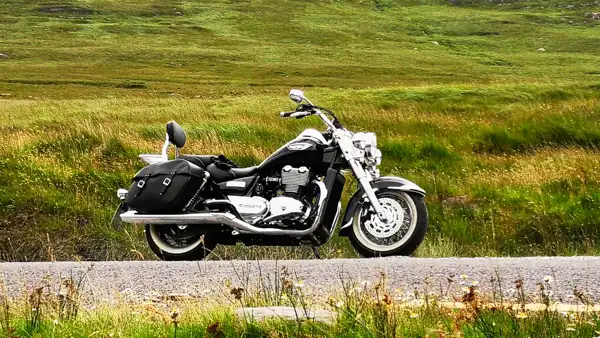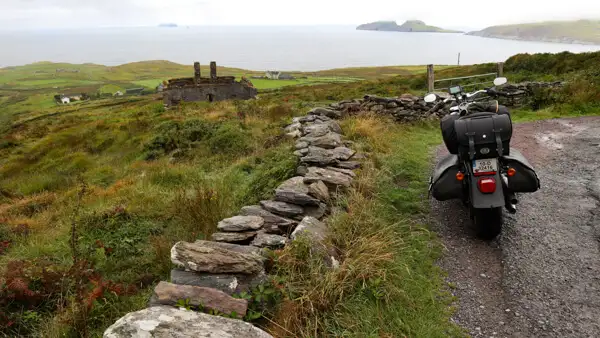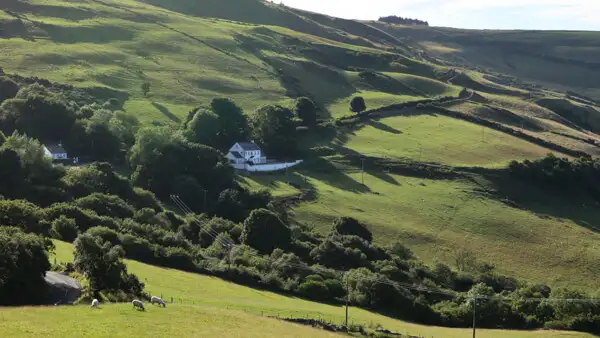Do you know Murphy’s Law?
It says: If something can potentially happen, it will happen – the question is only when..?
By the way, Murphy is a very common family name in Ireland – coincidence?
Page Contents (click line to jump the text)

Intro
Anyway, nothing happens all year and everything seems to go wrong on your hard-earned holiday – what a bummer, and the bike has just been serviced!
I’ve done a lot of motorbike tours and had a few breakdowns. And I’ve seen many other motorcyclists who’ve had all kinds of breakdowns.
In my motorbike rental company in Ireland (update: we closed the shop meanwhile…), I pay very close attention to good maintenance of the motorbikes – but a nail in the tyre or a rollover on the road can still happen. By the way, we also have nice guest rooms.
I have put together a few tips on how to avoid motorbike breakdowns and a few tips on what you can do if it does happen.
Small disclaimer: I am not a motorbike mechanic and my experience is not to be taken as binding. Read your motorbike manual or talk to your motorbike mechanic for authoritative information.
Motorbike won’t start on the road (immediate help and prevention)
The battery on a motorbike is a sensitive creature. The more electronics the modern motorbike has and the more additional power consumers are connected, the more sensitive it is.
After a few years, a motorbike battery has only a fraction of its original capacity. When it is time to replace it depends very much on maintenance.
When your motorbike is stationary, you should connect a charger to the battery every 3 weeks and charge it once. This is not a big deal, if you connect a charger plug to the battery once, then you just need to plug in your charger when needed.
If you don’t drive for a few months in winter, you can also remove the battery once, charge it and then put it away. If it is not connected, it will last much longer, because there are often leakage currents on the motorbike.
You can also have the residual capacity of your battery tested at a motorbike workshop or buy a battery tester yourself. Then you know where you stand.
If your little darling does run low on the road, you can jump-start it yourself. There are battery boosters – small rechargeable batteries that fit easily into your luggage and give the battery the boost it needs. They also work as a power bank for your smartphone or tablet.

If you get a jump start from another motorbike, you should be able to access both battery terminals. You should have the necessary tools with you if necessary.
If you are jump-starting from a car, you should know that car batteries may be too strong, so you should only connect the positive terminal and hang the black negative cable on the (unpainted) footrest or another metallic surface. Read the manual for your motorbike.
Motorbike won’t start after the ferry
We see it on every long ferry trip. The unloading stops because a vehicle won’t start and is in the way. Either the lights were still on or the alarm system was howling the whole crossing. At some point, the best battery runs out.
Do you have a motorbike with an alarm system? Or do you have an older motorbike on which you still have to consciously switch off the lights? Then you know what to look out for.
Immediate assistance corresponds to the above point – jump-starting is called for and you should know what this should look like on your motorbike.
When motorbikes are exposed to the elements, switches and electrical contacts can suffer. The metal contact surfaces then become coated with a layer of corrosion that eventually no longer conducts.
Salty sea air is extremely aggressive to metal and accelerates the process.
You can uncover all important switches and contacts before and after the trip and spray them with an electrical contact spray. The oil will protect the metal surfaces. If you don’t want to do this yourself, talk to your workshop.
Nail or other object in the tyre
Unfortunately, this happens more often than you think, especially in Ireland. Why? Many car parks are only gravelled and you often can’t see what’s in the gravel.
The only thing you can do to prevent this is to keep your eyes open. It is also important to check the tyre pressure every now and then on the road so that you notice a gradual loss of air in good time. Many modern motorbikes have an air pressure monitoring system that warns you.
If it happens, a tyre pressure kit (tubeless tyres) or a tyre pressure spray (tubular tyres) will help you at least until the next overnight stop or workshop. A small mobile compressor is also a very good investment!
Irish workshops or tyre services may be able to patch the tyre professionally afterwards – this has a much higher reliability than your puncture kit. And in Ireland, tyres are repaired rather than replaced immediately. So you can continue your holiday without worry.
If you get stuck: The Irish version of the ADAC is the AA (www.theaa.ie). You can call them for roadside assistance, or use Google Maps to find the nearest roadside assistance service (keywords towing or roadside assistance).

No object in the tyre, but the tyre still loses air
Maybe you have some dirt in the valve? Let off some air and then fill it up again, this might already blow the valve free – of course only if you have a compressor with you. Otherwise, just use the compressor at the nearest petrol station.
As a preventive measure, keep your valves clean and always fit valve caps.
If that doesn’t help, you could have a fine crack in the tubeless rim, or the tube has a small damage – for that you need the nearest workshop.
Breakdown happens in the dark
Why do you drive in the dark? It’s light for a long time in summer, especially in the north? Good travel planning is already the best prevention.
The second best prevention is to drive very carefully in the dark, because even in Ireland there are animals on the road at night.
And if it does happen? Just in case, it makes sense to have a light with you so that you are visible to traffic and helpers. But not the light from your smartphone, you’ll still need that for the emergency call and roadside assistance. Your battery booster probably has a built-in light. A yellow high-visibility waistcoat is also a good idea.
Motorcycle drop – Pannier broken off
Plastic cases in particular can break off, but this can also happen with aluminium cases! If you have two longer lashing straps or a piece of thin rope (cord) with you, you can fix the case temporarily.
Preventive measure: Choose a motorbike where you can get a good grip on the ground with your flat feet, then you are less likely to tip over. If the bike is lighter, this will also help.
Motorcycle drop – footrest bent or broken
This is not uncommon either – you can use pliers or a long screwdriver to temporarily straighten the footrest. You can also remove it if that helps more. This might get you to the nearest workshop where a new footrest can be fitted.
As a preventive measure, side crash bars at the front and side bags or side cases at the back help a lot. Then the motorbike does not land on the footrests and levers in the event of an overturn, or at least not as much.
In addition, these “spacers” also help to ensure that your leg is not trapped in the event of an overturn and that you can easily get out from under the motorbike.

Motorcycle drop – brake or clutch lever bent or broken
The levers on the handlebars can also be severely bent or broken and then a small overturn quickly becomes a big problem – how do you ride on without the clutch?
The plastic hand guards on many motorbikes are of little help in the event of a fall. Much better are sturdy steel handguards, to which plastic shells can also be bolted.
Alternatively, there are half brackets that are screwed to the end of the handlebars or levers that have an additional joint so that they fold out of the way on impact.
You don’t have any of these and the lever is “very short”? Then only the breakdown service can help…
Accident – motorbike unroadworthy, what to do?
The emergency number in Ireland is 112 or 999. In Northern Ireland the emergency number is 999. The police will also call a towing service.
If you have an ADAC cover, you can call their contact number and they will help you with the procedure.
Your motorbike insurance will probably pay for towing to the nearest garage, but there are maximums (e.g. €250), above which you pay yourself.
Breakdown service in Ireland and Northern Ireland
We’ve actually been through this already…the counterpart to ADAC in Ireland is the AA (www.theaa.ie). The AA also has a cooperation with the ADAC (or your national auto-motor-club).

Insurances
What is the holiday policy for your motorbike insurance? Normally there is a maximum of 3 weeks, beyond that you will need to take out other insurance.
There are a variety of travel insurances or protection letters that you can take out separately, e.g. with the ADAC (in Germany). You might want to find out if there is one for you before your trip.
Self-help package: Tools and other aids on a motorbike trip
It doesn’t hurt to have a small tool kit. In addition to chain maintenance, you should also be able to access the battery or adjust the folded mirror.
Some tape and string or lashing strap will help you to fix loose parts.
A tyre repair kit or spray is a must in your luggage, and a small compressor is also very helpful.
If you still have room for a battery booster with power bank and lamp, that’s not a mistake either.
Add to that the yellow high-visibility waistcoat and a first-aid kit, and you’re already well equipped.
Good maintenance of the motorbike beforehand is probably the best preparation for a breakdown.
I wish you a good trip and as few breakdowns as possible!
More interesting articles for you
HOW CAN I PREPARE MYSELF AS A RIDER FOR THE IRELAND MOTORBIKE TRIP?
PREPARE YOUR MOTORBIKE FOR YOUR TRIP TO IRELAND – BE WELL PREPARED AND SAFE ON THE ROAD!
MOTORBIKE HOLIDAYS IN IRELAND – THE 14 MOST BEAUTIFUL CLIFFS ON THE WILD ATLANTIC WAY
MOTORBIKE TRIP IRELAND – WHICH REGION SHOULD I GO TO?
Photo credits cover photo: Motorcycle on a mountain at sunset, photo by Ulrich Knüppel-Gertberg (www.irland-insider.de, www.ireland-insider.com)